 Spike Lee’s film, Do the Right Thing, depicts racial tensions on the hottest day of the summer in Bed-Stuy “do or die” Brooklyn, New York. The film addresses topics in black culture such as fashion and style, mental illness, racial stereotypes, boycotting and police brutality. It is important to note that the portrayal of African-Americans is illustrated in both a literal and figurative manner to display the history, art and culture of the black community during the late 1980’s and until this day. I invite you to join me on an exploration of the story line, character displays and messages conveyed throughout the film.
Spike Lee’s film, Do the Right Thing, depicts racial tensions on the hottest day of the summer in Bed-Stuy “do or die” Brooklyn, New York. The film addresses topics in black culture such as fashion and style, mental illness, racial stereotypes, boycotting and police brutality. It is important to note that the portrayal of African-Americans is illustrated in both a literal and figurative manner to display the history, art and culture of the black community during the late 1980’s and until this day. I invite you to join me on an exploration of the story line, character displays and messages conveyed throughout the film.
The opening credits of the film are an artistic display of dancing and boxing performed by, Rosie Perez, who is a famously known dancer, choreographer, actress, and community activist. The song playing over the dance routine is one we hear played over and over throughout the film, representing the main takeaway: Fight the Power by Public Enemy
Character Review & Analysis

Mister Senor Love Daddy – “Today’s Forecast”
The first character we are introduced to is Mister Senior Love Daddy; he is the local radio host who shares the daily news and events on the block as they unfold. His radio show starts in the morning with the sound of an alarm clock to wake up everyone for the day to come. He even gives the weather forecast for the day: “HOT!” This radio personality/DJ is one of many parts of the cultural and artistic features of the film. He wears colorful clothing and speaks his mind; he is a first hand reporter with recitations of the news, character introductions and comic relief. The music that broadcasts from his radio station overlays the transition between and during scenes in the film. He is a character to remember, especially because he’s played by well known actor, Samuel L. Jackson.
Smiley – the Mentally Impaired
The next character introduced is Smiley. He is a young, mentally impaired man who has a speech impediment. Throughout the film, he attempts to sell pictures of Malcolm X and Martin Luther King, Jr. to people in the neighborhood, mainly Mookie. We meet him with a lovely “Good Morning” outside of the Yes Jesus Christ Baptist Church, drawing on the picture of Malcolm X and Dr. King, saying who they are and what they did. Later, he tries to sell Sal, the local pizza shop owner, but Pino, his son and worker, loses his temper and tells Smiley to go away. One of our elders, Sweet Dick Willie is heard defending Smiley off-screen. Smiley insults the worker, who insults him back.
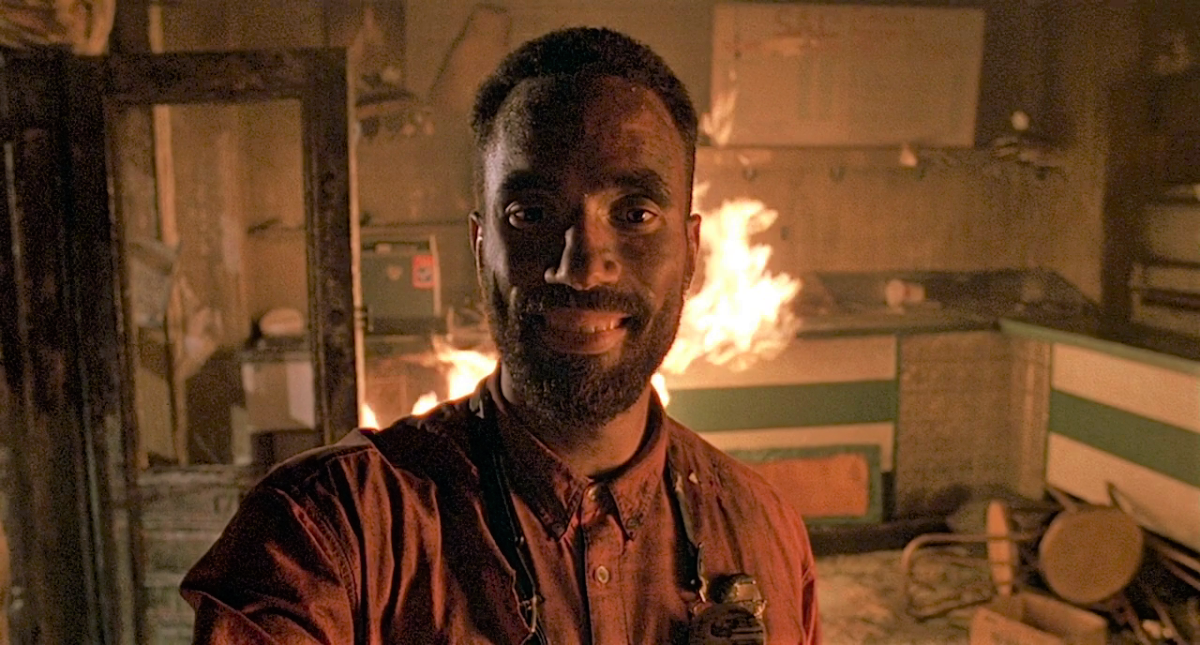
At nightfall, Smiley joins Radio Raheem and Buggin’ Out at the pizzeria, and after Sal destroys their property in frustration, Smiley joins in on the fight. The cops are called and the situation escalates; an unarmed black man dies at the hands of police brutality. Smiley is seen running down the street after the police car, sobbing. While the witnesses are arguing and shouting, Smiley informs us, “one of the police was black!” After the pizzeria is burned down by the locals, Smiley is last seen inside with the song “Fight the Power” playing in the background as he puts a picture of Malcolm X and Martin Luther King Jr. on the destroyed Wall of Fame and smiles with satisfaction.
Smiley plays an important role in this film; he represents the obvious information that we should see as the audience. It’s a way of saying, you don’t have to be mentally impaired to understand the facts that he presents from talking about historically black figures like Malcolm X and MLK to his expression of emotions and what he says and does to defend himself and other characters around him.
ML, Sweet Dick Willie, Coconut Sid – The Elders “Peanut Gallery”
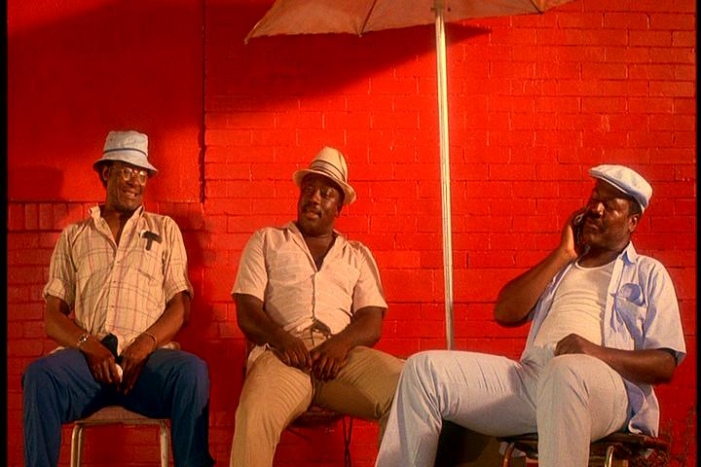
ML, Sweet Dick Willie and Coconut Sid are three older gentleman who sit outside in fold out chairs under an umbrella the entire film. They don’t seem to play a significant part until you look at them on an individual level without the other characters and situations of the film. When you pay attention to them you’ll realize that they represent the elders of the neighborhood bringing wisdom and perspective to situations they see around them, yet also provide commentary and comic relief with their silly back and forth antics.
Sweet Dick Willie and Coconut Sid provide most of the lines in their scenes discussing Mike Tyson, joking about being broke and even making fun of each other’s names. While, ML provides a more serious tone in his commentary addressing the issues of global warming stating that the polar ice caps are melting and how Koreans have businesses in black areas but black people don’t own anything.
Mookie – the Pizza Delivery Boy

Mookie, played by none other than Spike Lee himself, is the protagonist of the film. He works as a delivery boy at Sal’s pizzeria which is down the block from his apartment. He is introduced in the film counting his cash tips and getting ready for another day of work. Early on in the day, we see Da Mayor stop Mookie on a delivery to give him a reminder, “always do the right thing.” Throughout the day, Mookie is faced with addressing racial tensions related to why there aren’t any black representations on the Wall of Fame at Sal’s, the use of the “N” word and racial stereotypes of black people in America, the history of black civilization, the battle of love and hate, his job security being threatened, Sal flirting with his younger sister and the killing of an unarmed black man at the hands of the police.
Mookie is exhausted from the weather, all the racial tension and just general bullshit of the day. He picks up a trash can and throws it through the front window of Sal’s pizzeria. This is a symbol of destroying social injustice; Radio Raheem represented the potential change for social justice and rising to fight the power but now he has been killed by the power of police officers a.k.a. “the man” so as a whole we must rise together against “the man” and the person who summoned “the man”, Sal who represents “the establishment”. The neighborhood locals and eye witnesses to Radio Raheem’s death receive and accept the message that Mookie is sending; they start a riot that leads to the destruction of the entire pizzeria.
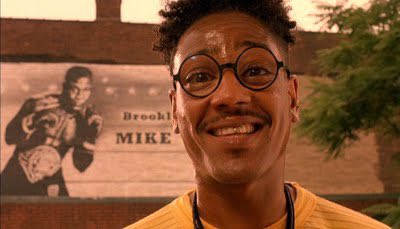
Buggin’ Out first appears in the film when getting served pizza by Sal. The slice of pizza he receives is rather small and he stares at it for a moment, confused. Sal asks for the money, to which he replies: “how much?” Sal and Buggin’ Out go back and forth about the integrity of the slice of cheese pizza. Buggin’ Out lets it go, pays for the slice and sits down in a booth. When he looks up, he notices that there are not any black celebrities or historical figures on the Wall of Fame. Sal explains that only American Italians go on the wall and that if Buggin’ Out does not like it, he can open his own shop and create his own Wall of Fame. Buggin’ Out creates a ruckus and is threatened by Sal with a baseball bat to get out of his pizzeria. Buggin’ Out is escorted out by Mookie and tells everyone in the shop to boycott Sal’s. He spreads the word to other characters throughout the film as well. Mookie tries to comfort Buggin’ Out by telling him to come back in a week for the issue to be resolved.
The next scene we see Buggin’ Out in, he walks up to Mookie and calls him “The Man,” clearly illustrating that he feels better about the situation that occurred earlier at Sal’s pizzeria which is good news for Mookie. He’s happy to see his friend happy and it also reminds him of the promise he made. Mookie leaves. A white man enters the scene, guiding his bicycle down the block and pushes Buggin’ Out by accident. The bicycle runs over Buggin’ Out’s brand new Air Jordan sneakers leaving a scuff mark. Buggin’ Out lives up to his name and goes off on the white man. The locals are clowning him and making jokes about how bad his sneakers look and how they’re done. Later, we see Buggin’ Out with a toothbrush scrubbing out the scuff mark, which isn’t working.
The last scene we see Buggin’ Out in, he’s with Radio Raheem and Smiley at Sal’s pizzeria arguing about why there aren’t any black men on the Wall of Fame and that they’re going to boycott Sal’s for good. Buggin’ Out continues to yell while the music from Radio Raheem’s boombox continues to play Fight the Power, ringing louder and louder in Sal’s ear until he can’t take it anymore. He grabs his baseball bat and destroys the boombox. A chilling silence is left and everyone looks around at each other until Sal says, “I just killed your fucking radio…” Radio Raheem reaches over the counter, grabs Sal, pulls him over it and a fight breaks out. Pino calls the police; they arrest Buggin’ Out and kill Radio Raheem with a baton to his neck in the choke-hold position. Sal blames Buggin’ Out for his pizzeria being destroyed saying that he started it with ideas of boycotting and causing the fight to break out.
Radio Raheem – The Messenger/The Message
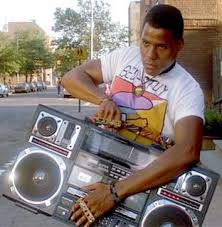 Radio Raheem is a character that journeys through the neighborhood interacting with most, if not all, of the other characters, carrying his boombox from one scene to the next. The song of the day for Radio Raheem? Fight the Power by Public Enemy. In one of his interactions, he goes to Sal’s pizzeria and orders two slices. Sal refuses to serve him until he turns off the music. Radio Raheem doesn’t want to at first but then when he realizes that Sal is serious and won’t serve him, he turns it off.
Radio Raheem is a character that journeys through the neighborhood interacting with most, if not all, of the other characters, carrying his boombox from one scene to the next. The song of the day for Radio Raheem? Fight the Power by Public Enemy. In one of his interactions, he goes to Sal’s pizzeria and orders two slices. Sal refuses to serve him until he turns off the music. Radio Raheem doesn’t want to at first but then when he realizes that Sal is serious and won’t serve him, he turns it off.
Radio Raheem is also seen interacting with Mister Senior Love Daddy outside the radio station, Buggin’ Out’s local crew, walking past the elders in the peanut gallery, the Korean shopkeepers for more batteries when his radio dies, but he especially takes a moment to catch up with Mookie.
He provides Mookie and the audience with a brief monologue about “Love & Hate”.
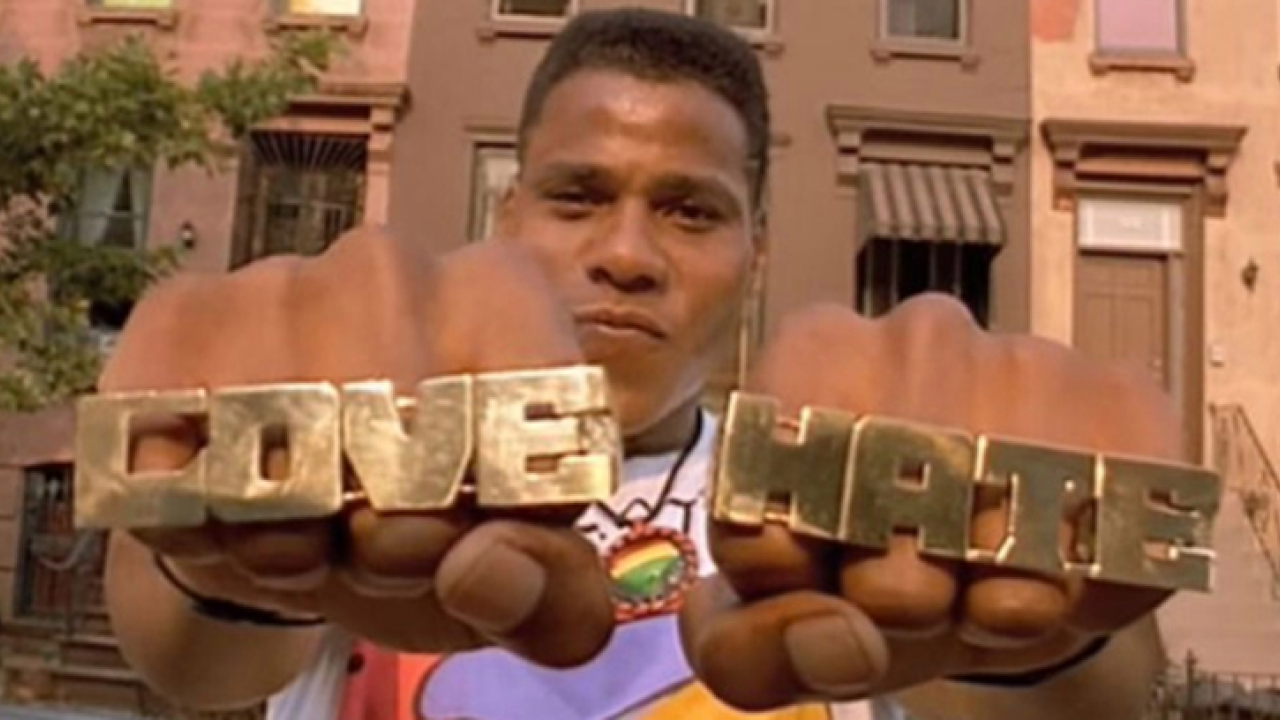


He explains the symmetry and symbolism of his four finger rings, “Let me tell you the story of Right Hand, Left Hand. It’s a tale of good and evil. Hate: it was with this hand that Cane iced his brother. Love: these five fingers, they go straight to the soul of man. The right hand: the hand of love. The story of life is this. Static: one hand is always fighting the other hand. The left hand is kicking much ass, it looks like the right hand, love, is finished. But hold on, stop the presses. The right hand is coming back. He got the left hand on the ropes now. Oh! It’s a devastating right hook. Oh! The left hand: hate, K.O.’d by love. If I love you, I love you. But, if I hate you?…” This monologue is a representation of the way human beings interact with each other. We love unconditionally and are always right in doing so. But when we hate each other, what is left behind? Nothingness.
The reason, Fight the Power, is the theme song of this film is that during the late 1980’s it was the message of unification, not only within the black community, but with all races in the neighborhoods of New York between blacks, Puerto Ricans, and Italians to fight the powers that be. Radio Raheem and Buggin’ Out together represented the social justice and respect that is owed to black people as citizens and residents of the Bed-Stuy neighborhood.
The death of Radio Raheem is still relevant in conversations today as a figurative and literal translation for the unjustified deaths of unarmed black men that continue to occur in America, i.e. Eric Garner and George Floyd. May they rest in peace and may their families receive justice and reparations for the damage caused by police officers who did not protect and serve them.
Representations of Art & Culture – late 1980’s
Street Graffiti (1): “Tawana Told The Truth”

This racially influenced background is in reference to the Tawana Brawley case of 1987, where an African-American women from Wappingers Fall, NY was found in a trash bag, several feet from an apartment where she lived at the time with racial slurs written on her body and covered in feces. She accused six white men of raping her, one of which she said had a police officer’s badge. The charges she pressed against the men gained national attention, mainly due to her age (15 years old) and race. The media received heated criticism from the African-American community while Tawana was, not only victimized in her accusations but also, charged for defamation of character by her abusers. She did not win the case because of suspicions that she had attended a party and jumped in the trash bag on her own will and that the feces came from a neighborhood dog. These perspectives caused mistrust in the black community and created confusion due to the legal allegations against her.
Street Graffiti (2): “Dump Koch
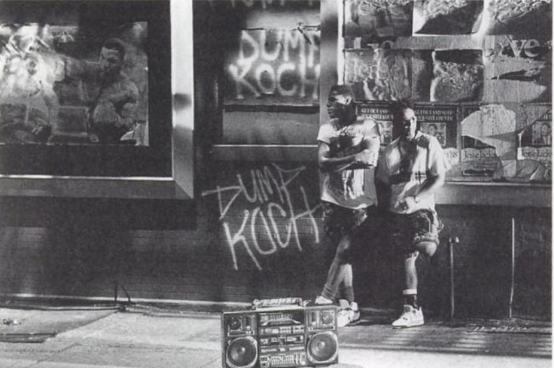
The screenplay is dedicated to and features the names Michael Stewart and Eleanor Bumpers, two African-Americans who died at the hands of New York police officers. Spike Lee deems NYC Mayor Koch responsible for Bumpers’ death, which is the reason we see “DUMP KOCH” graffiti in a scene with Radio Raheem and Buggin’ Out posted on a wall before entering Sal’s pizzeria as a foreshadowing device to Radio Raheem’s death.
Honorable Mentions
- One of Spike Lee’s favorite films is Night of the Hunter (1955). He pays homage to Robert Mitchum’s story of “love and hate” with Radio Raheem’s monologue.
- The film was inspired by an actual event that occurred in 1986.
- It’s difficult to find a scene that does NOT have the color red in it. Red is a warm color and illustrates the heat of the weather and rising racial tension.
- Going to see this film in theaters was Barack and Michelle Obama’s first date.
- Nominated for the Outstanding Motion Picture, NAACP Image Awards (1989)
- Winner of the Best Picture, Chicago Film Critics Association Awards (1990)
- Winner of the National Film Registry, National Film Preservation Board USA (1999)
- Winner of the Classic Film Tribute, Gotham Awards (2000)
- Spike Lee Interview with Brian Linehan’s, City Lights (1989)
- Spike Lee discusses Do The Right Thing, Tiff Talks (2019)
- Spike Lee Interview on George Floyd and Donald Trump, DW News (2020)
- Spike Lee on Making History Current “Da 5 Bloods”, with Trevor Noah (2020)
